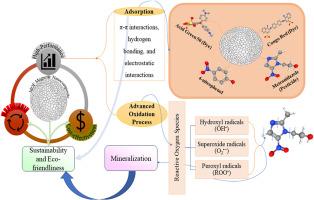MOF-derived magnetic nanocomposites as potential formulations for the efficient removal of organic pollutants from water via adsorption and advanced oxidation processes: A review
IF 7.9
3区 材料科学
Q1 GREEN & SUSTAINABLE SCIENCE & TECHNOLOGY
引用次数: 0
Abstract
This review article summarizes current developments in the design and application of metal-organic framework (MOF)-derived magnetic nanocomposites (MNCs) to remove organic pollutants (OPs) in water efficiently. In the review, various methods for synthesis, like in-situ encapsulation and post-synthetic modification, have been discussed, showing how magnetic nanoparticles incorporated into MOFs resulted in materials that had improved adsorption and advanced oxidation processes. These NCs showed unique structural characteristics and functional advantages given their large surface area, tunable pore sizes, and magnetic separability. This work has emphasized dual functionality concerning adsorption and photocatalytic degradation. More importantly, these processes synergistically cooperate to realize considerably high removal efficiencies for a wide range of OPs. It also addresses current challenges on stability and scalability issues and proposes possible ways of improving MOF-MNCs' performance. This is followed by future research directions on the betterment of the practical application of MOF-MNCs in controlling water pollution, highlighting their potential as a feasible and effective solution for mitigating water contamination. Lastly, it is proposed in this synthesis that Ishikawa 5Ms should be considered when developing low-cost MOF-MNCs and industrializing their application for water depollution.

MOF 衍生的磁性纳米复合材料是通过吸附和高级氧化过程高效去除水中有机污染物的潜在配方:综述
这篇综述文章总结了设计和应用金属有机框架(MOF)衍生的磁性纳米复合材料(MNCs)高效去除水中有机污染物(OPs)的最新进展。综述中讨论了各种合成方法,如原位封装和合成后改性,展示了将磁性纳米粒子融入 MOF 中如何产生具有更好吸附性和更高级氧化过程的材料。这些 NC 具有独特的结构特征和功能优势,因为它们具有大表面积、可调孔径和磁性可分离性。这项工作强调了吸附和光催化降解的双重功能。更重要的是,这些过程协同合作,实现了对各种 OPs 的相当高的去除率。研究还探讨了目前在稳定性和可扩展性方面面临的挑战,并提出了提高 MOF-MNC 性能的可行方法。随后介绍了未来的研究方向,即如何更好地将 MOF-MNCs 实际应用于水污染控制,突出其作为可行、有效的水污染缓解方案的潜力。最后,本综述提出,在开发低成本 MOF-MNCs 并将其工业化应用于水污染治理时,应考虑石川 5Ms。
本文章由计算机程序翻译,如有差异,请以英文原文为准。
求助全文
约1分钟内获得全文
求助全文
来源期刊

Materials Today Sustainability
Multiple-
CiteScore
5.80
自引率
6.40%
发文量
174
审稿时长
32 days
期刊介绍:
Materials Today Sustainability is a multi-disciplinary journal covering all aspects of sustainability through materials science.
With a rapidly increasing population with growing demands, materials science has emerged as a critical discipline toward protecting of the environment and ensuring the long term survival of future generations.
 求助内容:
求助内容: 应助结果提醒方式:
应助结果提醒方式:


